“What will become of us when we go to Wirikuta and can no longer find the tutuu (peyote flower)?” – question from a participant in “Let’s Talk About Hikuri,” a series of dialogs organized by Pedro Nájera and Lisbeth Bonilla. (photo at left: Antonio Moreno Talamantes, from Naturista.mx, some rights reserved – CC BY-NC)
This article is a part of Medicine Stories, an exclusive series for Intercontinental Cry made possible by a grant from the Elna Vesara Ostern Fund. This is the second story in a series about the traditional medicine of the Wixárika (Huichol) Peoples of Western Mexico. See Part 1, Healing the planet, healing themselves: Wixárika medicine transcends the personal.
WE DO NOT WANT TO LET THEM CONTAMINATE THE SACRED PLACES; WE WANT TO LEAVE SOMETHING BEAUTIFUL FOR OUR FAMILIES, AND FOR THEM TO LEARN TO KEEP THE PRACTICE. IT IS OUR TASK THAT FALLS TO ALL THE COMMUNITIES OF NAYARIT, DURANGO, JALISCO. LET US RAISE AND SOW THAT SACRED SEED, AND LET OUR PLANET NOT END, SO THAT ALL THAT IS BEAUTIFUL REMAINS. PAMPARIUS. —MARA’AKAME JOSÉ LUIS RAMÍREZ “URRAUMIRE”
When a Wixárika elder speaks of his culture, he starts at the beginning of time. He then takes you through a storied journey to the five directions — the five cardinal sacred sites to which his people have travelled since time immemorial. The Wixárika must cross half of Mexico’s vast expanse from desert to sea, in order to leave their offerings, gather the sacred waters and connect with the wisdom they need to live their lives. Each step on this journey and each stop at a sacred spring renews the essences of life and the reciprocal relationship between humankind and the more-than-human world.
Dig a little deeper and you will find that each of those five principal sites—and many sacred sites in between—now face numerous threats due to incursions from transnational mining corporations, hydroelectric dams, commercialization, narcotrafficking and conflicts within the communities themselves. It’s a symbolic geographical representation of the existential threat that these iconic and deeply spiritual people are confronted with in this modern age.
Compounding the situation is the troubling evidence that the medicine at the heart of the Wixárika cosmogony, Lophophora williamsii, peyote, or in their language, Hikuri, is rapidly disappearing. The cactus has come under unprecedented pressures in recent years, leading one researcher to predict its possible extinction in the wild within as little as a decade—if current trends continue.
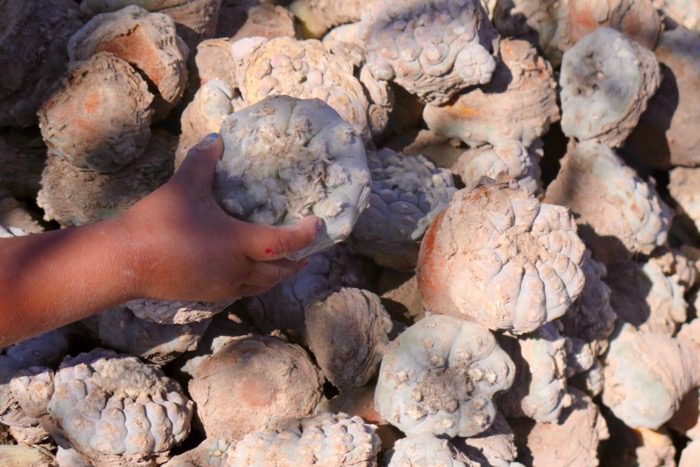
Others believe the threat is exaggerated, and plays into the hands of those who want to prevent access to what is a lifesaving medicine for thousands by classifying it as a Class 1 controlled substance – thrusting the ancient cactus into the maelstrom of Mexican peyote politics. Unfortunately, very little controlled research is being done to determine the true status of the species; all concerned, however, agree that its extraction has seen an alarming increase and that its habitat is under rising pressure
“I think it’s really important to try and understand how heartbreaking it is for so many of the elders… They often don’t say this in public but there is this sense of concern of what’s happening and what it could mean,” said Diana Negrín, a Guadalajara native, a researcher at the University of San Francisco and president of the board of the nonprofit Wixárika Research Center.
“Although this is an important plant for so many people, for the Wixárika people its disappearance is beyond tragic,” said Negrín. “It means an end to this whole web of life and practices.”
Large-scale threats
The Wixárika creation story begins with the first humans landing on the Pacific Coast of Mexico at a place they call Haramara, a sacred site where the Mexican government has ceded land to developers for a mass tourism complex. The Wixárika believe this project has altered the hydrologic cycle of the region, causing it to dry up the springs connected to the watershed. The loss of their water supply has compelled indigenous communities of the area to turn to nearby contaminated rivers for their water needs, the Regional Wixárika Council has alleged in a formal complaint issued in February of this year against the government and the developers. The use of this water has led to the eventual death of at least 15 indigenous community members, including children.
Today’s Wixárika pilgrims follow – sometimes in pickup trucks, sometimes in buses, but always with long treks over the rugged landscape – in the footsteps of their ancestors on the trails that connect Haramara in the West to Wirikuta in the East, the sacred desert where their sun was born, and where they go to gather their medicine and seek guidance and orientation for their lives. That desert is under threats of its own from transnational mining companies, large-scale industrial agriculture, peyote traffickers and now a hydroelectric dam project. Much of the protected natural area of Wirikuta has been concessioned to transnational and Mexican mining companies by the federal government, opening the way to an unthinkable desecration for the Wixárika people. A mass movement and court orders have held those mines in abeyance, but those restraining orders are working their way through the court system and could soon be overturned.
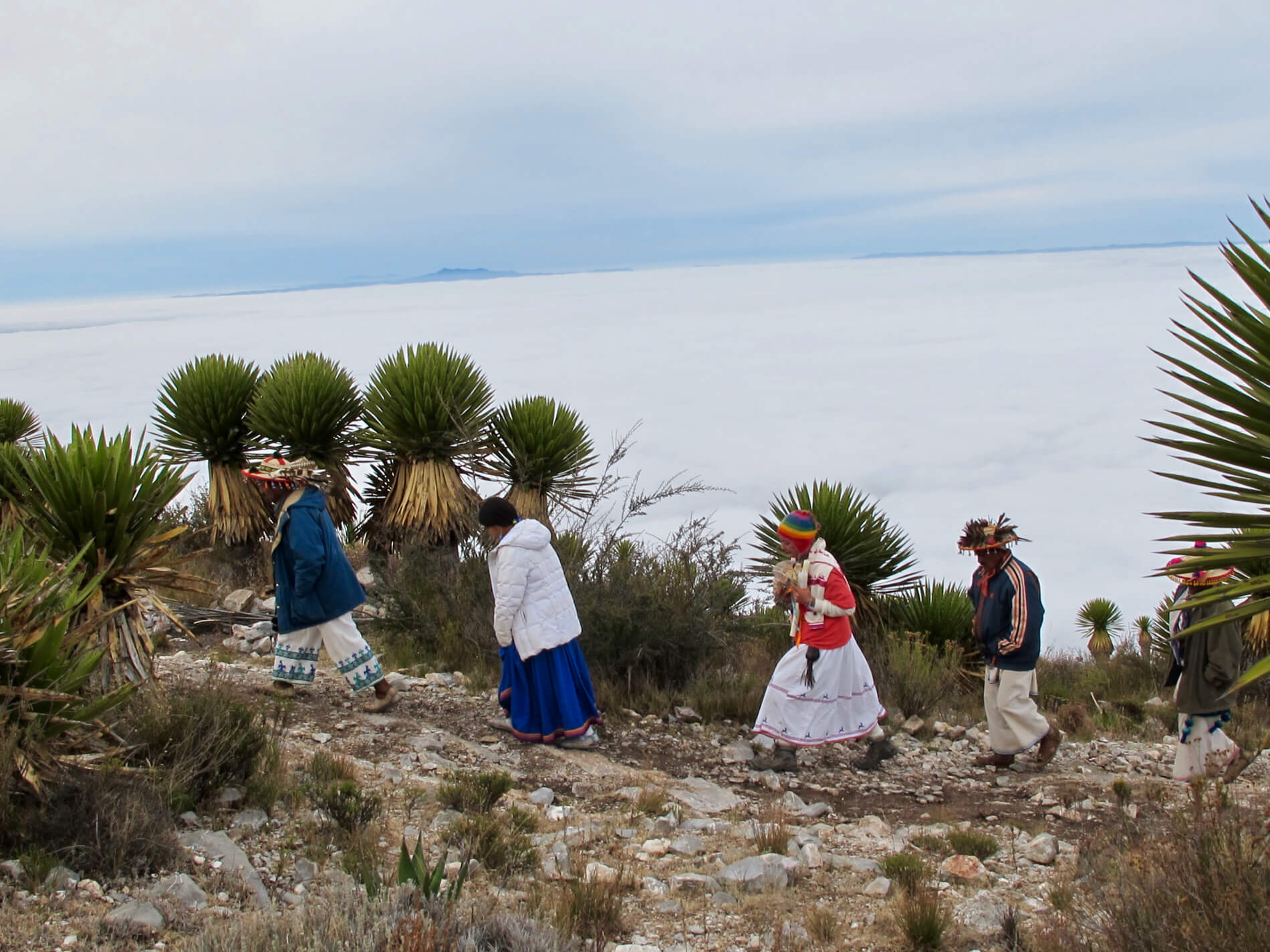
Participants in the historic mass pilgrimage to Wirikuta’s Cerro Quemado on Feb. 8-9, 2012, make their way to the xiriki, or house of the gods, at the top of the Cerro Quemado; a sea of clouds carpets the desert below as far as the eye can see. (Tracy L. Barnett photo)
Each of the five cardinal directions has its own threatened site: Xapawiyemeta, the Island of the Scorpions in Lake Chapala, a heavily impacted lake whose water is piped into Guadalajara for that city’s use; the island itself has been thoroughly commercialized for tourism, with taco and beer stands within a stone’s throw of the xiriki, a house for the gods where pilgrims come to leave their offerings. To the north, Hauxa Manaka, Cerro Gordo in Durango is plagued by narcotraffickers, as is the homeland and the sacred Center.
Beyond the five principal sites, the Mexican landscape is dotted with literally thousands of other sacred areas, many of which are currently under threat.
“That’s another element that’s so difficult to negotiate, because Wixárika territoriality sacralizes our Earth in so many different places,” said Negrín. “And so when you see simultaneous development projects occurring across these different territories it becomes a really big challenge.”
For the Wixárika to follow their religious path and lead a successful and happy life, they are obligated to travel to each of these cardinal sites personally, at least once, and depending on their assigned position, perhaps many times. Failure to do so – no cumplir – is punishable by terrible misfortune.
“You hear so many stories about the implications of no cumplir,” said Negrín. “With personal implications and collective implications and in fact the global implications… when people start to connect it with climate change, with what is happening to Wirikuta, with what is happening to the peyote – it is emblematic of what we are doing to our Earth in general.”
Disappearing medicine
Negrín recently participated in the International Congress on Sacred Plants in the Americas, held in February in Ajijic, Jalisco, and the heightened concern over the issue was evident. The sad irony was lost on no one: The increasing appreciation of the value of this medicine in healing the wounded human spirit and exploring the potential of human consciousness comes at a time when the plant itself as well as the culture are uniquely challenged.
“I think a lot of us who supported the movement for Wirikuta have had a hard time wanting to fully accept that unfortunately there has been a spike in the illegal extraction of peyote,” said Negrín. “Part of it is plain and simple trafficking; apparently there’s an increased consumption of powdered peyote in Spain; you can find it on the deep internet, in Thailand – so there’s been a shift, and it’s important to understand what that shift has meant and the increasing impact it’s having on the space of Wirikuta.”

After the pilgrimage to Wirikuta, women and girls set about the task of cleaning the harvest, removing the seeds and small hairs at the center of the cactus. (Tracy L. Barnett photo)
One of the presenters at the conference was biologist Pedro Nájera, who did a four-to-five-year studymonitoring 70 different sampling transects within the protected area of Wirikuta and other sites in the Chihuahua Desert. Tracking an alarming drop in the number of peyote buttons, Nájera’s study found that 50 of the 70 sites were severely impacted, with a 40 percent reduction in the number of cacti counted. Twenty of them, most of which were in the extremely remote harvest areas associated with Wixárika ceremonial sites, showed a slight growth in species. Nájera estimated that if current trends continue, the species could be driven to extinction within 10 to 15 years.
Nájera, a native of the state of San Luis Potosí who has conducted multiple studies of desert plants for state and federal agencies, began monitoring the hallucinogenic cactus of his own accord about seven years ago when he began noticing serious impacts on the species. In a recent interview, he shared his perspective that the decline in the species derives from “the anthropocentric vision we have towards things, because we view them in terms of the function of what benefits us, or makes us feel good… (that people) believe, in some very strange way, that the soul magnifies itself while driving a species to extinction.”
Among the misconceptions he identified to be driving that trend: Nobody is reforesting the species in Mexico, and even if they were, very few know how to do it correctly; most people who harvest the peyote believe that cutting only the buttons is enough to save the species; those who leave offerings for the plant leave items that have no value for the species, only for humans (e.g. coins, candles, feathers, stones); increased commercialization of the plant; recent trends that have made it “cool” to be a “peyotero.”
The cactus is extremely slow-growing, Nájera said, taking 10 years to reach reproductive maturity. Contrary to popular belief, cutting the largest fruiting body in a cluster of cactus makes it incapable of sexual reproduction; cloning is still possible but the plant becomes more vulnerable to predators and to frost, he said. He documented multiple instances of such damage to traditionally harvested cacti.
Others make no attempt to preserve the root, simply taking the entire plant. At one point, he saw a huge family of peyotes calculated to be 100 years old. The next year it was gone; only a huge crater was left.
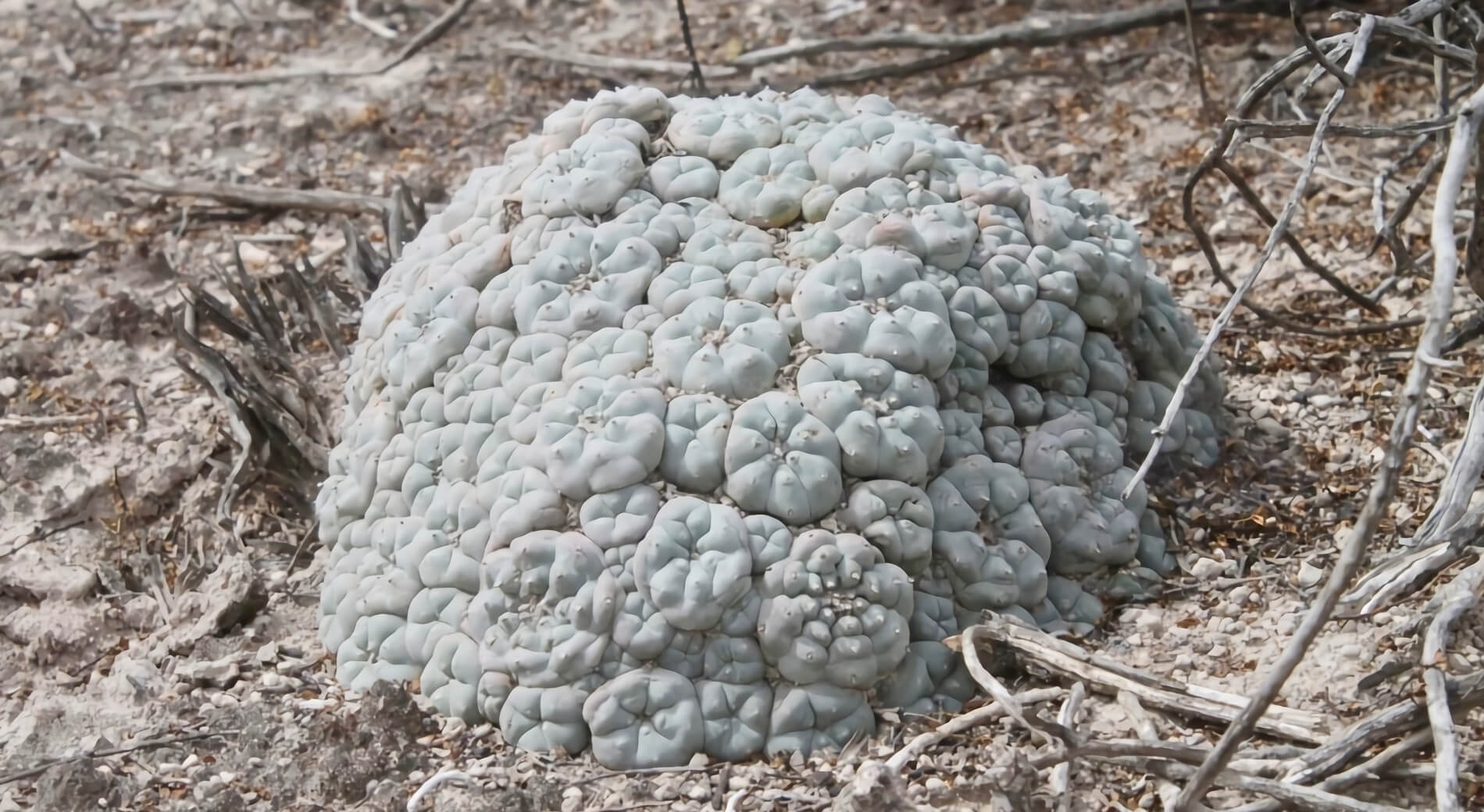
This cluster of cactus, found by researcher Pedro Nájera during the course of his study, was estimated to be around 100 years old. The following year when he went to check on its progress the plant was gone. (Pedro Nájera photo)
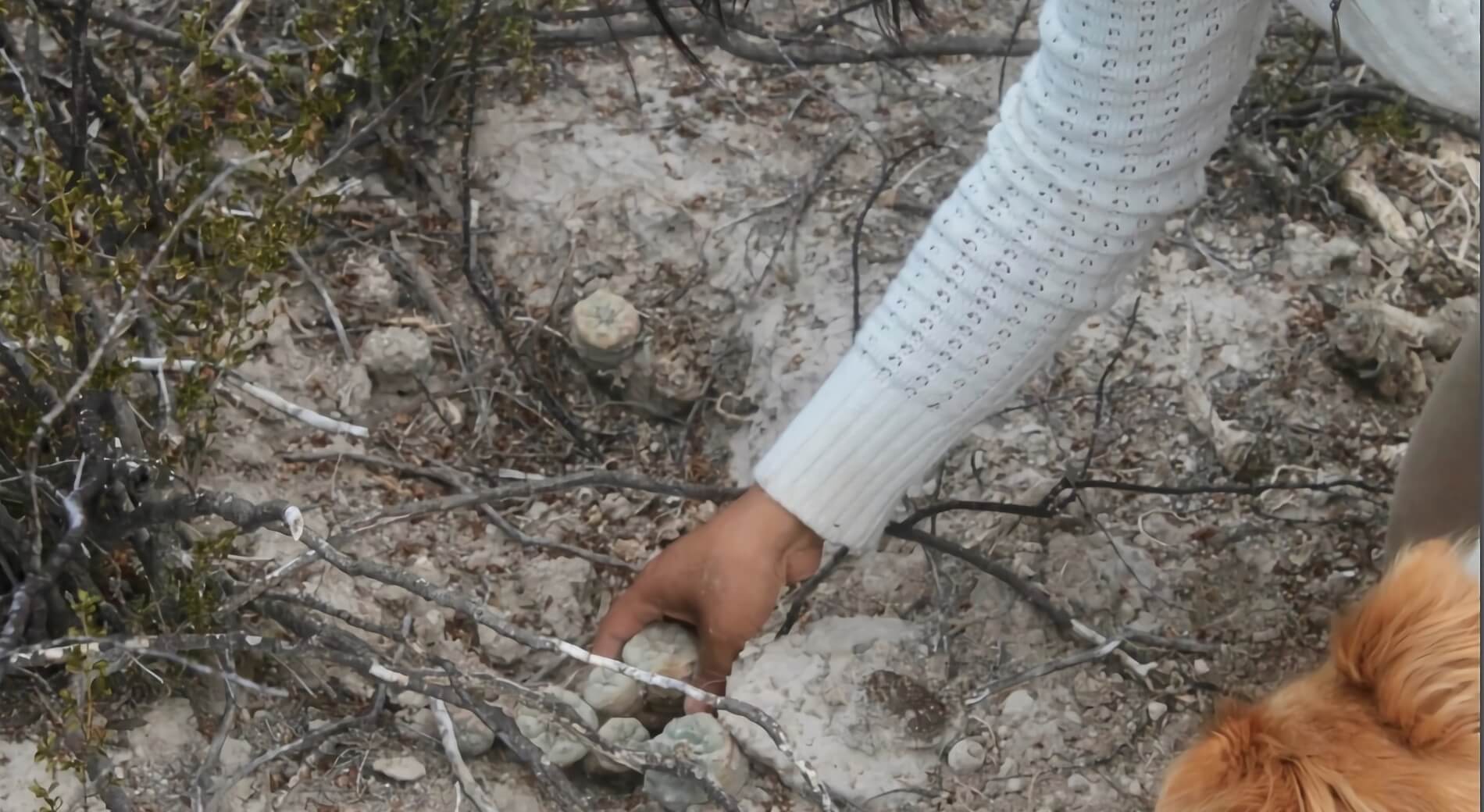
Volunteer replants abandoned peyote cactus. (Pedro Nájera photo)
Legalization, rise in popularity and the role of the Native American Church
Aukwe Sofia García, a young Wixárika leader who serves as a spokesperson for the Wixárika Regional Council, is deeply concerned about the decline of the species, and like many of her people, attributes the spike in extraction to people who do not have a cultural connection to the plant. For those people, they can turn to other types of medicines, she said; but for her people, the peyote is their sole connection to the Divine.
“There are those who say that it should be legalized but I think it should not be, because for us it is a deity, and that has to be totally respected as a millenary culture, because it will not be as sacred for others as it is for us. For us that deity is Kayumari, the Blue Deer,” she explained. “For my family, and for me, this situation is not easy to digest. We are concerned above all for the preservation of our culture, because it is a channel for communication with the deities, and to feel that the Hikuri could be extinguished, we could lose our culture for this extinction, and that future generations might not be able to realize the culture as it is, beyond other problems, this is the main concern. Because that is why we go to Wirikuta, to communicate with the Deities; then if that does not exist, how are we going to communicate with them? Even if songs are made, we will not have that vision of the sacred.”
Alarmed at the prospect of extinction, García takes a hard line. “All people who are alien to our culture are traffickers, because they are not in a legal framework to extract the Hikuri or take it to other parts. These people can be drug traffickers, tepees, or normal people who want to connect spiritually with the plant or with God, but they are still a trafficker because it is not in the law. Those who seek it to sell or seek it for their spiritual interest both affect us on a different scale as a culture because they are not respecting the amount that exists.”
Armando Loizaga, of the Nierika Center for the study and preservation of traditional sacred plants, was another presenter at the Sacred Plants conference. Loizaga made it clear that the Wixárika are far from the only group that considers the peyote a sacred medicine. A leader of the Native American Church in Mexico and closely linked with the Church in the U.S. and Canada, Loizaga is also a licensed psychologist and a strong advocate for the plant’s legalization for therapeutic use.
“Peyote saves lives,” he said, calling it a “medicine for the neocolonial wound.”
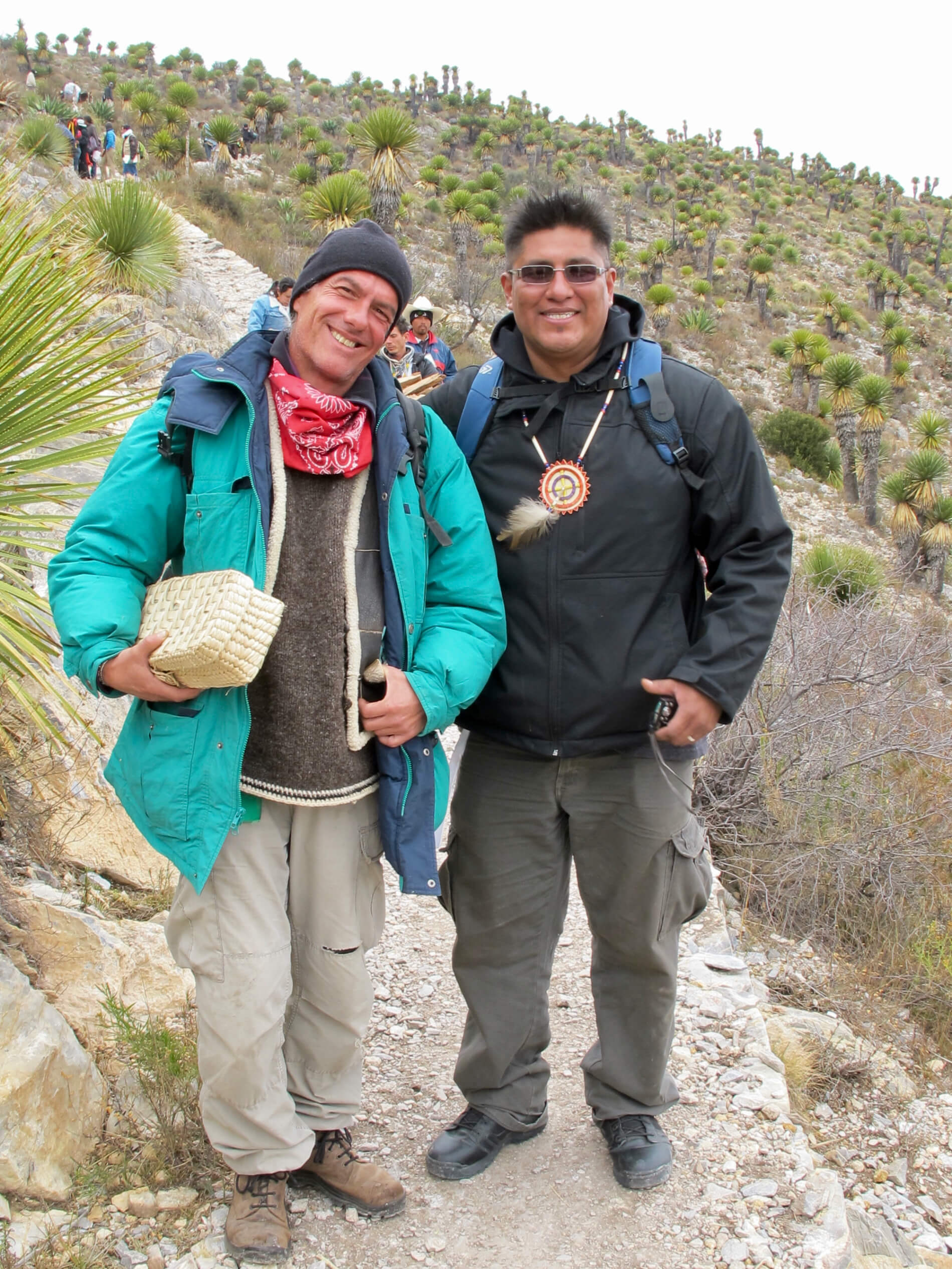
Armando Loizaga, left, and Sandor Iron Rope on the Cerro del Quemado, participants in the prayer to save Wirikuta from the transnational mining threat. (Tracy L. Barnett photo)
“You can see how it has restored many indigenous people by embracing their culture,” he said. “The peyote is kind of a transversal element; it doesn’t matter which tribe you’re from, you take it through the Native American Church and you just become more Lakota, more Diné, more Kiowa, more Cree. So it’s a very important medicine for the future of Native American people — but not only that it’s good for humanity.
“Because when you look at it, it’s good to tend to the wound of the indigenous people — but it’s also important to straighten out the psyche of the white people. And the white people also suffer, and we’re also a part of that one Medicine Wheel and that one race. So it’s important that we find the ways where peyote becomes sustainable for cultural and medicinal use; that it becomes regulated, where not anybody can use it but certain groups with certain permissions and uses and observances.”
He acknowledged the importance of Nájera’s work but called it “a bit alarmist,” given that the plant is still relatively plentiful and that there are virtually no other recent studies that explore the matter. Nierika is currently a partner along with the Native American Church and the River Styx Foundation in theIndigenous Peyote Conservation Initiative, which has purchased 605 acres of peyote habitat in South Texas and is working to reforest it. The project also seeks to work with Wixárika leaders to establish a systematic monitoring project and a conservation management plan for the resource in the Wirikuta area.
At the conference and also in a February article in the international magazine Xerophilia, Nájera presented a table based on 1976 data from biologist Richard Evans Schultes, considered the father of ethnobotany. The data showed that members of the Native American Church are by far the largest traditional consumers of peyote, both in terms of number of ceremonies (weekly in the U.S. and Canada, monthly in Mexico) and in terms of the quantities consumed. Wixárika communities traditionally consume the medicine in one annual ceremony following the spring pilgrimage, but researchers say that is changing, as well, in part due to growing interest by non-indigenous people in attending ceremonies.
Loizaga called the data misleading, saying that the vast majority of Native American Church consumption is in the U.S. and Canada and comes from several extensive ranches in South Texas controlled by dealers licensed by the U.S. government. The Native American Church of Mexico does harvest its medicine in Mexico, he said, but has a much smaller membership and impact.
He, too, however, is concerned about the recent spike in extraction, and attributed it to traffickers for the international market.
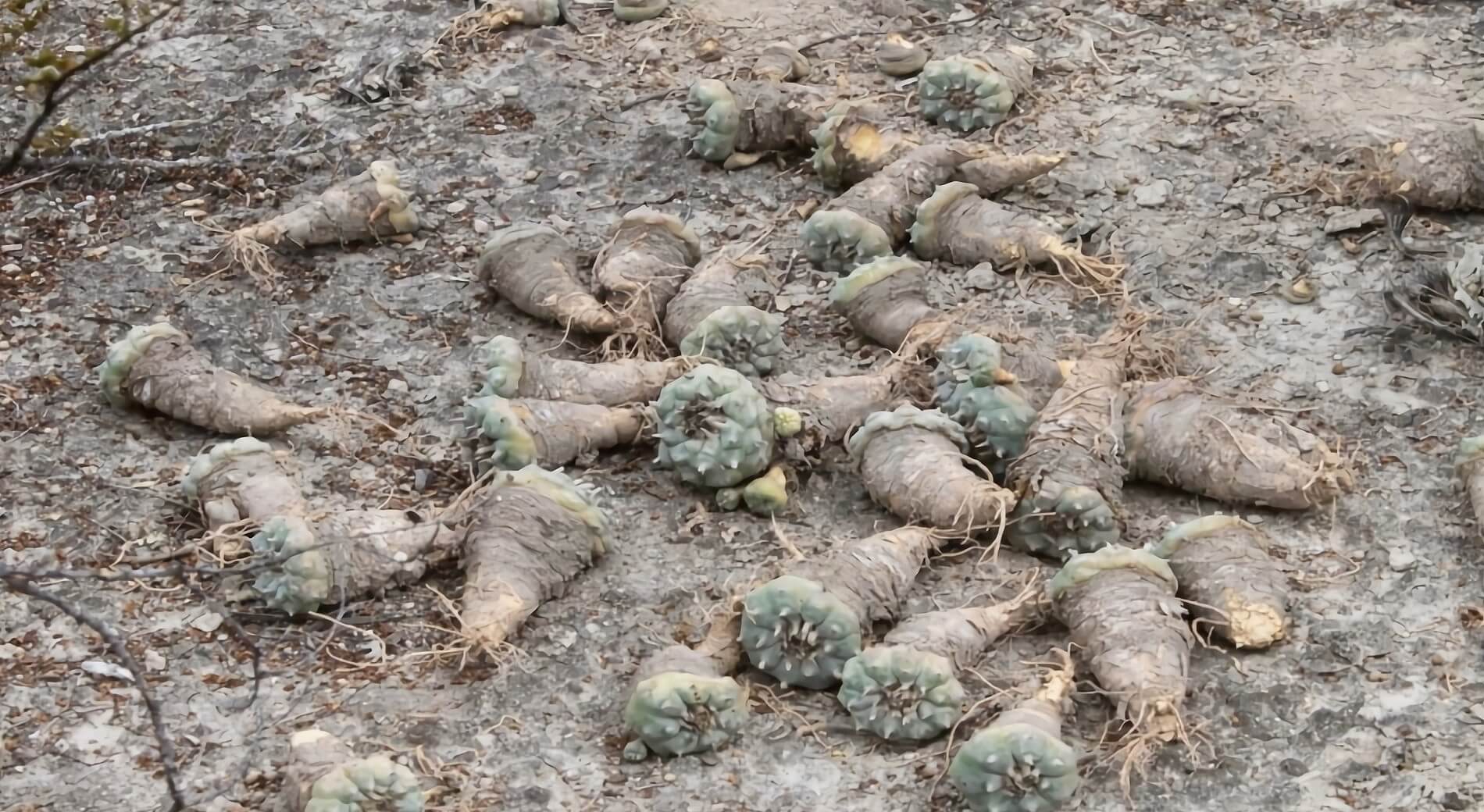
Peyote cactus left behind by traffickers. (Pedro Nájera photo)
“The concern is real — but it’s not the Native American Church, and it’s not even people who use it in a tipi,” he said. “It’s a gang of people who are overharvesting, and they apply some kind of chemical to produce a separation of the vegetable product and they extract the totality of the 80-plus alkaloids into this very fine golden dust. And they sell that as mescaline – and it’s not mescaline, it’s just extracted peyote. And that industry needs to be stopped… so maybe there you do a little intelligence work and you go get them. You can’t just go out and be chopping heads and say everyone who is not a Wixárika and is using the peyote is breaking the law. However, an organized crime type of enterprise where they are extracting tons of peyote, and working in laboratories in San Luis Potosi, well then let’s go get these guys — because that’s where the extraction is actually happening.
“But I think a prohibitionist criminalized model of prosecuting peyote users as trafficking in Class 1 equivalent to cocaine and methamphetamine and heroin in this country is preposterous, from whichever way you want to look at it – ethically, from a legal perspective, putting someone in jail for eating a medicine that is a medicine for Indian people but not for white people? I mean, come on. We’re living in the 21st century, and from a human rights perspective, our right to pursue our spirituality and our communion with the plants or with the different cultural opportunities that are available to us. So what are we going to do when a Wixárika invites us to a ceremony? So it’s a complex time. But I think it’s a medicine for the people, and I think sustainability is the key.”
Sandor Iron Rope, past president of the Native American Church of North America and currently president of the South Dakota chapter, was emphatic in his rejection of the idea that Church members are coming down and sacking the peyote population in Wirikuta.
“There’s no real way of doing that,” he said. “It’s not legal to transport it (across the border); there’s always a black market, but the Native American Church does not condone those practices, we are not part of that.”
Iron Rope attended the Sacred Plants conference as well and was taken aback by the direct attacks on him and other Native American Church representatives – in one case by mining company representatives, but in another case, by a conference attendee who accused him personally of sacking the desert.
“The misconception about us from the North taking the medicine, it’s just that, a misconception,” he said. “It’s like: OK, the Native American Church is coming to steal your medicine.”
Beyond the logistical difficulties of trafficking the plant, there’s another factor inhibiting Church practitioners from sourcing their medicine in the black market: It’s against their religion.
“When you look at the medicine here there’s always a prayer involved in indigenous communities, and so we’re building on those prayers,” he said. “The Wixárika people actually came to the Native American Church in 2011 to seek our support for the preservation of the sacred site of Wirikuta, and we have continued to build on that prayer. If there is no prayer then it’s almost effectively heresy.”

Efren Bautista, then governor of the Wixárika community of San Andres Cohamiata, blesses Earl Arkinson, president of the Native American Church of North America, after a night of ceremony between church members and the Wixárika delegation in Mirando City, Texas, in February 2011. (Tracy L. Barnett photo)
He and Loizaga both wondered aloud if there was a hidden source of some of the anti-Native American Church sentiment: mining and other private development interests, for whom an indigenous union in favor of conservation in the desert could prove to be an impediment. Regardless of where that feeling comes from, Iron Rope said, it must be respected and addressed.
“These are real concerns from the younger generation,” he said. “So we want to reiterate the correct harvesting, the plot management, and gaining access to the peyote lands, legally — this is the cultural patrimony of their way of life, and yet the private ownership of the land is what we’re up against. So we’re really trying to share with the Regional Council about what it is to have ownership of some land. But the goal is to empower the Wixárika People through conservation of the medicine, for their generations, and to feel secure that their culture, their medicine, their corn, everything will continue for generations to come.”
A growing threat
Beyond the spike in transnational extractive industries laying siege to Wixárika land, there is another, bigger and more menacing industry permeating the region: the red blush of opium poppies is spreading in Wixárika lands throughout the Sierra as the cartels grow in power and influence. Wixárika authorities are powerless to stop it; a year after the murder of Miguel and Agustín Vázquez, leaders in the long struggle to recover their ancestral lands, by cartel operatives, the assassins run free, and state and federal law enforcement appears to have washed their hands of the entire region.
“I have seen their presence, of course, but I mind my own business,” said a Wixárika from Santa Catarina. “There’s a main road that goes through there, and you have to be careful…. They’re just watching.”
Someone else confirmed a worrisome presence, declining to speak further on the subject. But the next day, he sent photos of poppies.

More mundane and also more omnipresent incursions of modernization are everywhere. Negrín grew up immersed in the Wixárika culture through the work of her parents Yvonne and Juan, and especially her father, who began developing an intimate relationship with one of the most remote and insular communities, Santa Catarina or Tuapurie, in the 1970s before highways came to the region. Since that time, cell phones and satellite dishes have brought mass culture to the Sierra, and young people compelled to continue their studies in the city often drift away from their traditions.
Fewer and fewer youths are taking up the hard path of the mara’akame, said Negrín and Garcia, who herself studied law and communications at Guadalajara’s Jesuit university ITESO before returning to her community of San Andrés Cohamiata to help support the continuation of her culture.

Santo de la Cruz, a member of the Ramírez family, applies the peyote design to his cheeks prior to the evening’s ceremony using uxa, a root found in the desert of Wirikuta, to heighten the connection with his deities. (Tracy L. Barnett photo)
“The lack of interest is like a hallucination — maybe because of technology, the different way of looking, the religion,” she said. “The Wixárika did not have that, we always had our own culture, our traditional practices, then when discovering that new world one wants to adopt another kind of culture, dress differently, listen to different music, that makes a person feel good because a stereotype has been created, that that is the good thing, and people have forgotten what is our culture, that we have subsisted through the years of history, and that right now we are leaving the culture. And the evolution of culture is valid but conservation becomes more important then, because otherwise we would become the same as so many without culture, without an identity of their own.
“As a solution to this challenge it is ourselves as a culture and a family, wanting to share this culture with our children… Often people who know do not share it easily, even with their relatives, so it is necessary to open ourselves to the younger generations, who also learn from this science, culture, tradition, art, healing, vision, learning to master oneself so as to achieve it, so the first challenge is with our own selves.
“After that, to teach us to value ourselves, as Wixárika people, not to discriminate against ourselves or the knowledge we have, to erase the negative stereotypes.”
To that end a mixed blessing has been the increase in interest and visits from non-natives, even in the most remote communities.
“It’s a complicated thing because there’s something very powerful about the way the Wixárika approach the world and our way of being in the world – and also their way of approaching healing,” said Negrín. “In that approach, one has a huge responsibility to sacrifice and to have a reciprocal relationship with people around us and with the Earth.
“That said, I’ve heard of all the internal conflicts caused by the practice of (non-native) accompaniment. And I’ve heard this not just from non-Wixárika who have engaged in the rituals and consumed peyote. For the most part, people first had an encounter with the peyote and wanted to find a way to understand the experience, which often brought them to Wixárika culture.
“But that has caused a lot of pressure on the shamans and their families – a lot of times we don’t see it, because when we leave those pressures linger.”
Some shamans have been forced to leave their communities for bringing in outsiders without going through the proper channels, which can in some cases be arduous. Others have been fined money for giving information to a researcher or even having a ceremony with people they’ve been close to for years, Negrín said.
This resentment partially stems from different philosophies about sharing the culture; partly it’s because of the scarcity of basic resources suffered in the communities, where a shaman can be seen as “selling” to a foreign public a gift that he’s been given for the care of the community. And partly it’s because of the critical role that mara’akate play in their communities, said Carlos Chávez of the nonprofit Jalisco Association in Support of Indigenous People, or AJAGI, who has worked with the Wixárika communities since the 1970s.
“In the Sierra they criticize the commercialization of some mara’akate who have clients in Mexico, in Morelia, wherever they go. And they work 8 or 10 days with people there and then they come back and they have money. But in order to go for money they are no longer attending the work that needs to be done in the village. Imagine the work of a mara’akame, when they are in charge their community, seeing to it that nothing bad happens to [the people], that they are being taken care of. You have to be very careful in that. It cannot be that they get distracted by going for money. Then people say, “No, you’re not even from here anymore, you don’t complete your responsibilities here.”

Mara’akame José Ramírez uses his rooftop and a sheet of black plastic to dehydrate thin slices of peyote for use in the year ahead. (Tracy L. Barnett photo)
“So those of us who don’t live in community can’t see that, but there they do see it that way, that the people who were given the mara’akame, who can see, who know how to dream, and so on, have an enormous responsibility. And it’s like — he’s not there, and he’s still not there, and people got sick and another got stung by a scorpion and the other fell into the ravine. And the one in charge, where is he? He left, he’s going around making money. Then apart from that they feel that it is damaging to the knowledge itself to go and sell the knowledge, to sell that relationship they have with the essence.”
Loizaga, however, sees the intercultural connections as a positive thing. “The contact with non-Huicholes and the Native American Church is not going to make a dent in Wixárika costumbre,” he maintained. “They know how to establish their relationships, and quite a few mara’akames have gone into tipis and prayed that way – it’s about a conciliatory tone and really just understanding a kind of inter-cultural empowerment – the fact that there are other indigenous cultures that use the same medicine. And it doesn’t have to be seen immediately as competition for the medicine, but rather as a coalition on behalf of the medicine, so that we could actually create this conservation project that will include the Wixárika people and all the indigenous groups and all the stakeholder groups who have a legitimate right to use the medicine in a responsible way. But to that notion of how the Wixárika culture might be affected – that’s a pretty bulletproof culture. I don’t think we need to take a paternalistic attitude and protect them.”
To Iron Rope, the answer is unity through mutual respect – and prayer.
“it’s always been about respect – respecting the tribes, and respecting the medicine — because this medicine is for the generations to come. So how can we put our minds together to unify on that initiative? The future of our medicine, for our generations.”